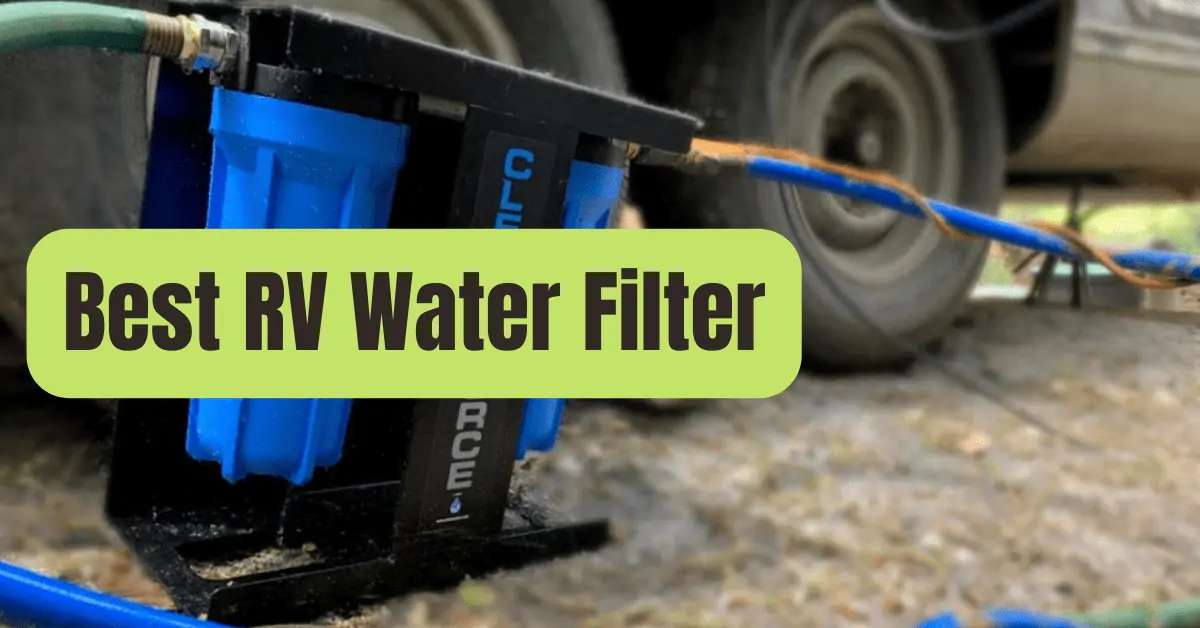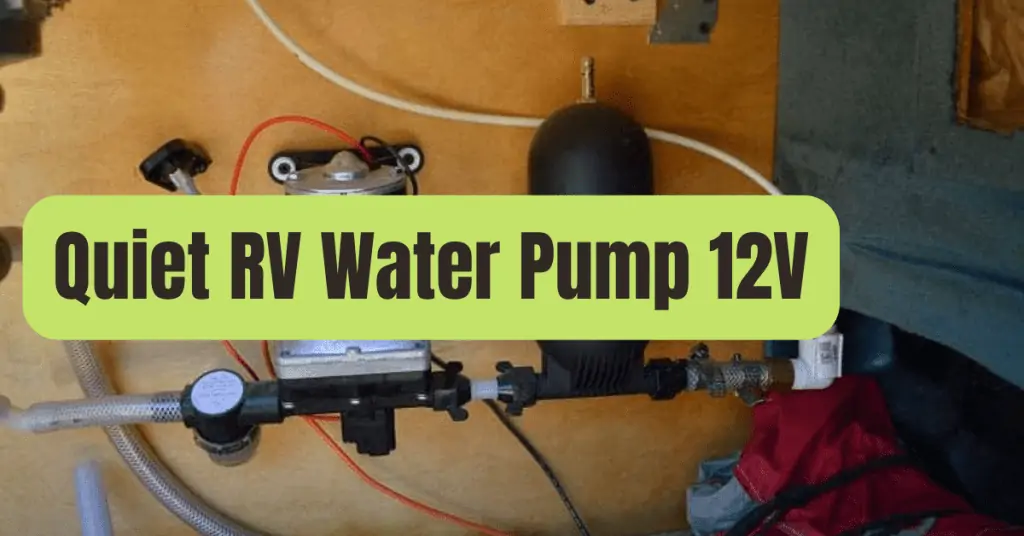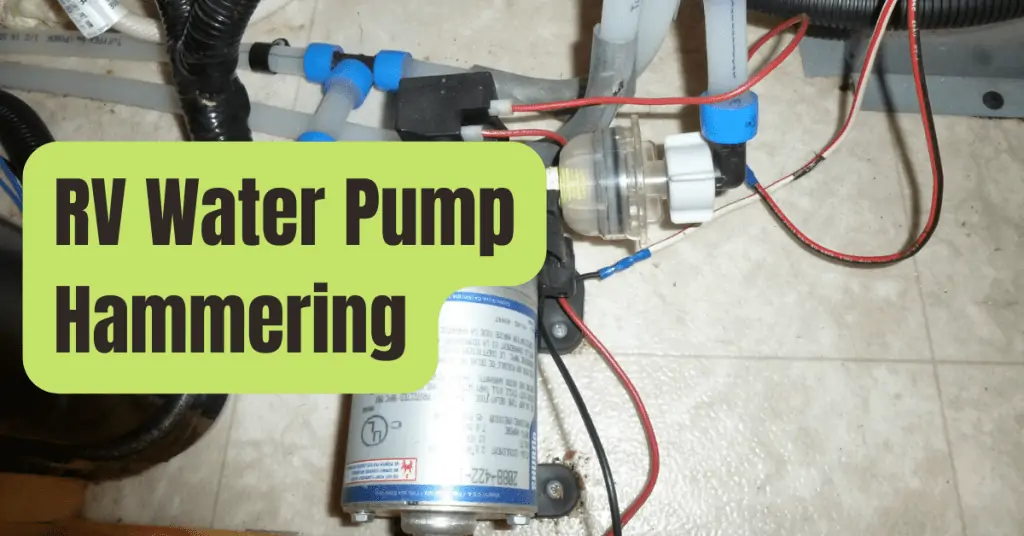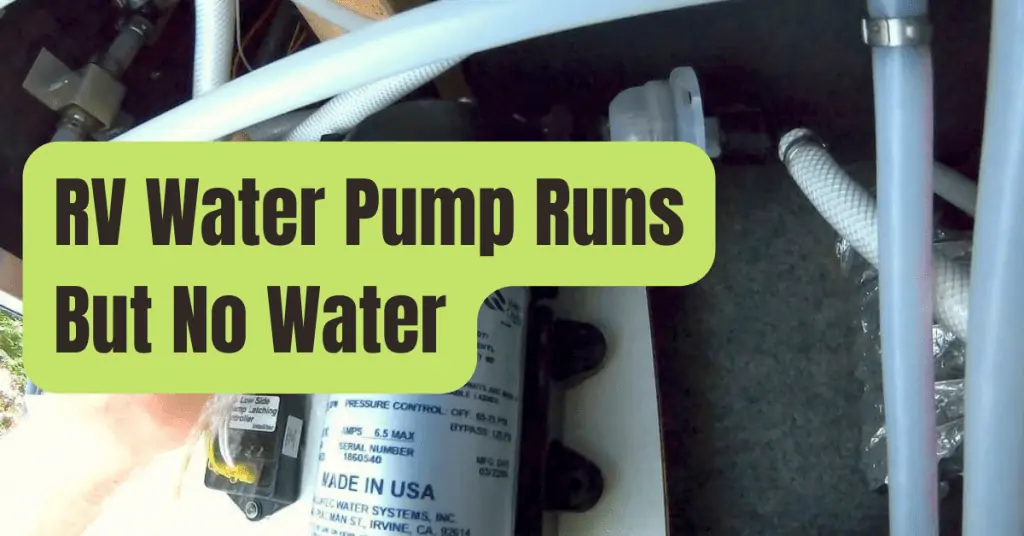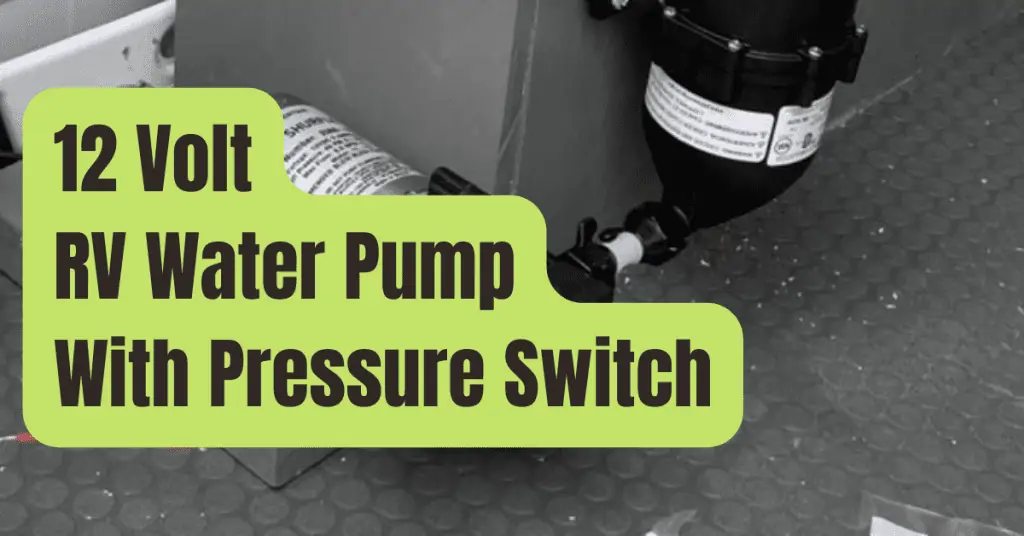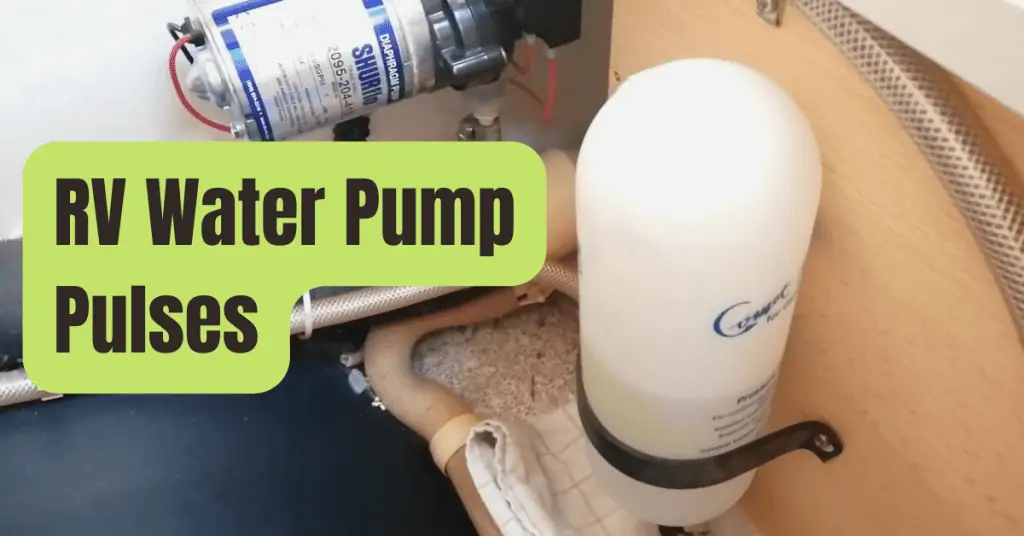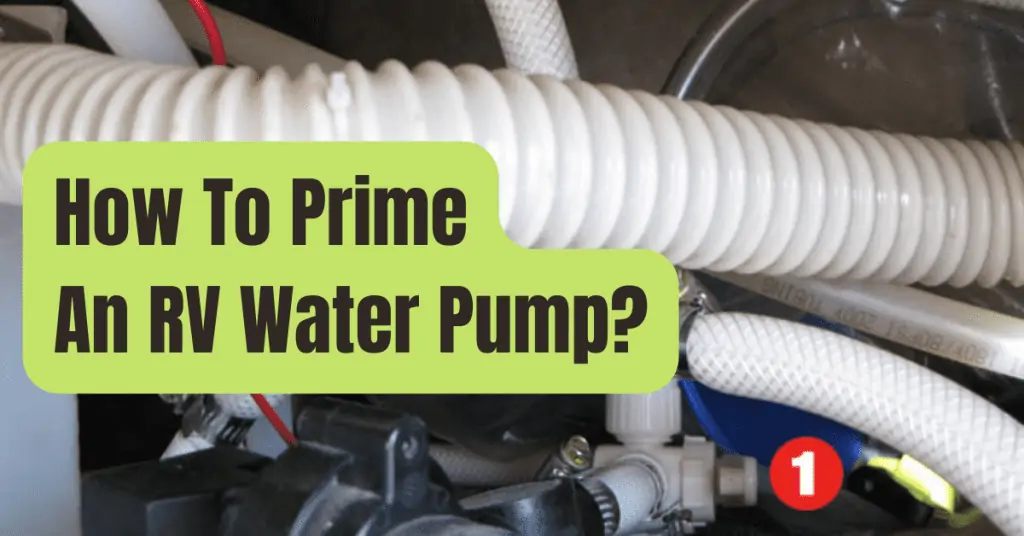The fact that the quality of the water you get depends on the campsite you’re staying at that weekend is one of the challenging aspects of living in an RV.
Additionally, if you have ever traveled extensively in an RV, you are aware that the water in campsites isn’t always of the best quality.
But when you take into account the possible negative effects of consuming unfiltered water on your health, the taste of the water becomes more of a matter of convenience and desire.
Giardia or cryptosporidium infections may leave you highly dehydrated, which may eventually create additional problems.
Not to mention the excruciating anguish brought on by ingesting hazardous germs or protozoa by consuming unfiltered water.
Therefore, outfitting your RV with the finest RV water filter is the greatest method to prevent pain and detrimental effects on your health from unfiltered water.
Fortunately, after surveying the market and determining which devices outperformed the competition, we’ve compiled a list of six good water filtration solutions.
After reviewing these six RV water filters, be sure to read our in-depth Buying Guide to discover how to choose the ideal RV water filter for your particular RV and way of life.
The 6 Best Reviews on RV Water Filters for 2024
Being really honest, it wasn’t simple to reduce our options to just six RV water filters.
But now that we are here, we must go into the particulars of each of these models.
So that you may utilize those high points (and negative points) when you learn how to evaluate various filters in our purchasing guide, pay particular attention to what we liked and didn’t like about each filter.
Here are the top 6 RV water filters to ensure that you always have clean, delicious water.
- Best Overall RV Water Filter: Camco 40043 Water Filter with Flexible Hose Protector
- Best Sediment Filter: ESSENTIAL Premium RV Water Filter with Cyst Removal
- Best Budget Filter: Hydro Life 52700 with Flexible Hose Protector
- Best with Durability: Clearsource Premium Pristine RV Water Filter System
- Best Under-Sink Filter: Waterdrop TSU 0.01μm Under Sink RV Water Filter
- Best Activated Carbon Filter: Culligan RV-800 RV Water Filter with Hose
- Best Three-Canister: Frizzlife Under Sink with Brushed Nickel Faucet SP99
- Best RV Reverse Osmosis: Waterdrop G2 RO Tankless Osmosis Water Filter
#1. The Camco 40043 Water Filter With Flexible Hose Protector Is The Best RV Water Filter Overall.
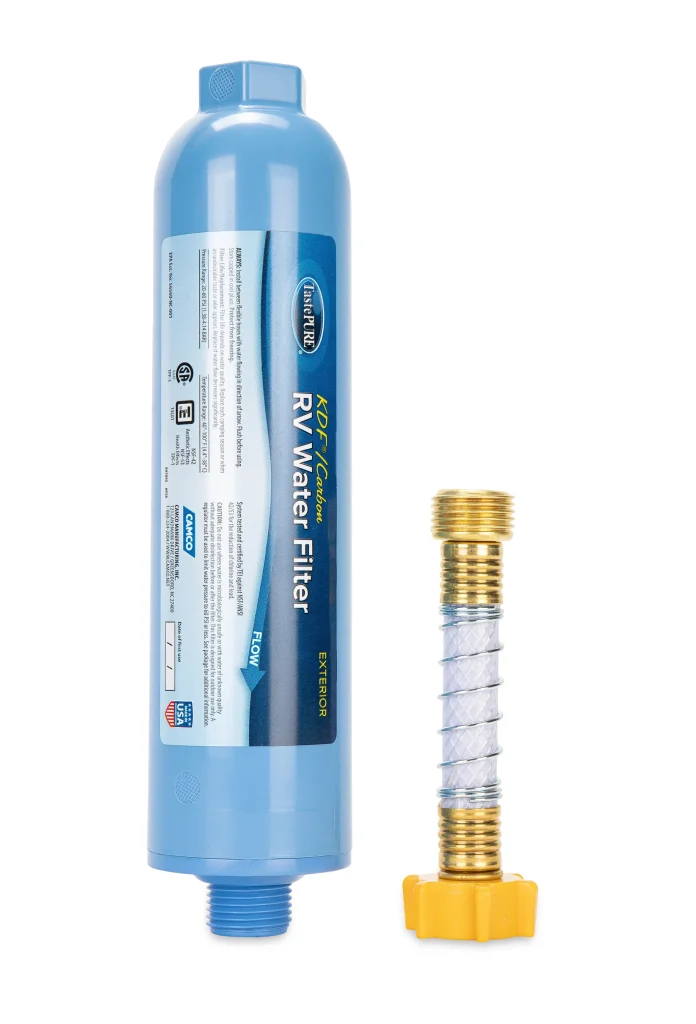
The Camco 40043 TastePure filter is our pick for the finest all-around RV water filter since it is very simple to install and is available for a very reasonable price.
This inline water filter has a filter element made of granulated activated carbon.
This substance reduces the chlorine content of your water while removing sediments and enhancing its flavor.
This design is adaptable enough to be removed and attached to any normal garden hose for use with boats, trailers, for gardening, or any other use you wish if you have any other circumstances that call for an inline filter.
This unit’s sediment filter features a 20-micron rating and KDF granules that prevent mold, germs, and fungus from growing within the filter when it isn’t being used often.
Additionally, this filter may get rid of additional heavy metals including mercury, lead, iron, cadmium, hydrogen sulfide, and aluminum.
Although Camco does advise changing this filter every three months, this is another instance when its reasonable price is advantageous.
Items We Enjoy
- Simple to Install: This is an inline filter that attaches to your municipal water pipe.
- Hose Protector Included: A hose protector is included to alleviate the weight off the filter and safeguard the integrity of the connections on either end.
- Versatility: This filter has almost endless uses and is compatible with any common gardening hose.
- KDF Granules: Assist in limiting the development of bacteria, mold, and fungus when the filter is being kept.
Things That We Dislike
- Filter Capacity: This filter has a maximum recommended lifespan of three months.
#2. Best Sediment Filter: ESSENTIAL Premium RV Water Filter with Cyst Removal
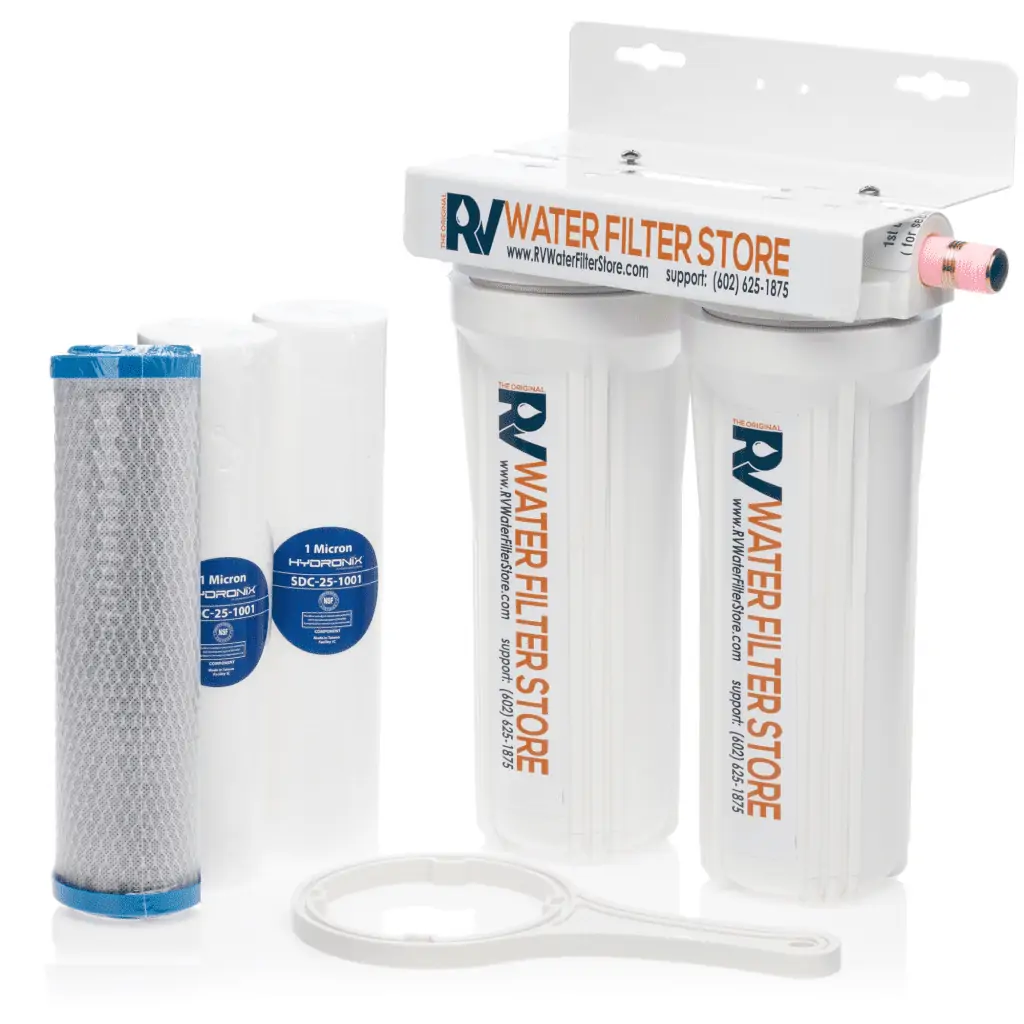
The Essential RV Water Filter System from the RV Water Filter Store is a great option if you’re looking for a heavy-duty sediment filter that gets permanently placed inside your RV since it includes the necessary 12-inch mounting bracket to assist you secure it within your RV.
The heavy-duty NPT connections on this filter are also far more resilient than regular hose fittings.
Installation could be a little more challenging as a result, but these fittings are far more resilient over time and less likely to leak if they slightly flex under the weight of the filter unit or your water line.
I like that this filter system includes an extra 1-micron filter so that you have it on hand in case you need to change it.
Additionally, since it is advised to change this filter every six months, you should be able to use it for at least a full year after receiving all of the necessary parts.
Before your water enters your RV, this filter eliminates sediments, giardia cysts, and pollutants from it.
As a result, it not only provides you with cleaner drinking water but also shields your water system’s pipes from the gradual development of pollutants or sediments.
Additionally, this filtering system has an excellent flow rate of 3–4 GPM at 60 PSI (pounds per square inch).
This implies that it won’t affect how well you clean your dishes or make it difficult to remove soap from your hair after a shower.
Items We Enjoy
- Heavy-Duty Fittings: These fittings are stronger than regular hose fittings and come in heavy-duty NPT varieties.
- Spare Filter: A spare 1-micron filter is included with this filter.
- Mounting Bracket: It comes with a mounting bracket to assist you attach it beneath your RV.
- Flow Rate: At 60 PSI, this filter can handle a flow rate of 3–4 GPM.
Things That We Dislike
- Installation: If you don’t have much plumbing knowledge, installing this filter may be challenging. It will need a more sophisticated installation.
- Fitting Compatibility: While the fittings on this filter are more robust, they are not compatible with a typical garden hose.
#3. Best Budget Filter: Hydro Life 52700 with Flexible Hose Protector
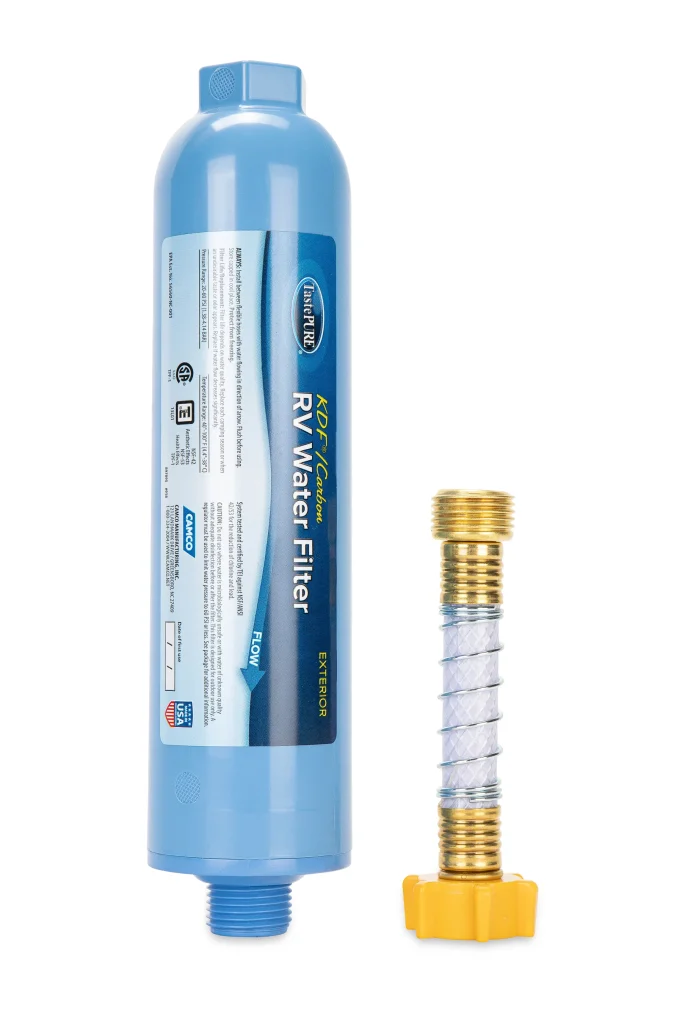
We advise looking at the Camco Hydro Life 52700 Inline Water Filter if you want to keep the cost of your new RV water filter down.
This filter is by far the least expensive option on our list and, like our Best Overall pick, it’s also incredibly customizable and simple to use.
It has a catalytic carbon filter, which is ideal for lowering the levels of chlorine and chloramines in your water to enhance its flavor and odor.
However, the filter also gets rid of heavy metals and silt.
The KDF granules in the filter unit also aid in limiting bacterial development on the filter element and within the filter unit.
This lengthens the lifespan of the whole device and ensures that the carbon filter element continues to function at maximum effectiveness.
This filter has an 8,000 gallon capacity and a 2.5 gallon per minute maximum flow rate.
Additionally, it has a flexible hose protection that lessens the strain put on your RV’s water connection spigot or the municipal water faucet.
Items We Enjoy
- Cost: Of all the RV water filters on our list, this one is the least expensive.
- Adaptability: This filter is capable of purifying water for a range of uses.
- Simple Installation: To connect your RV to city water, all you need to do is screw the adapter into the normal hose.
- KDF Granules: Extend the life of the filter element and protect it.
Things That We Dislike
- Usefulness: Since this filter is not permanently installed, you must attach it to your water hose each time you plug into a fresh municipal water connection.
#4. Best with Durability: Clearsource Premium Pristine RV Water Filter System
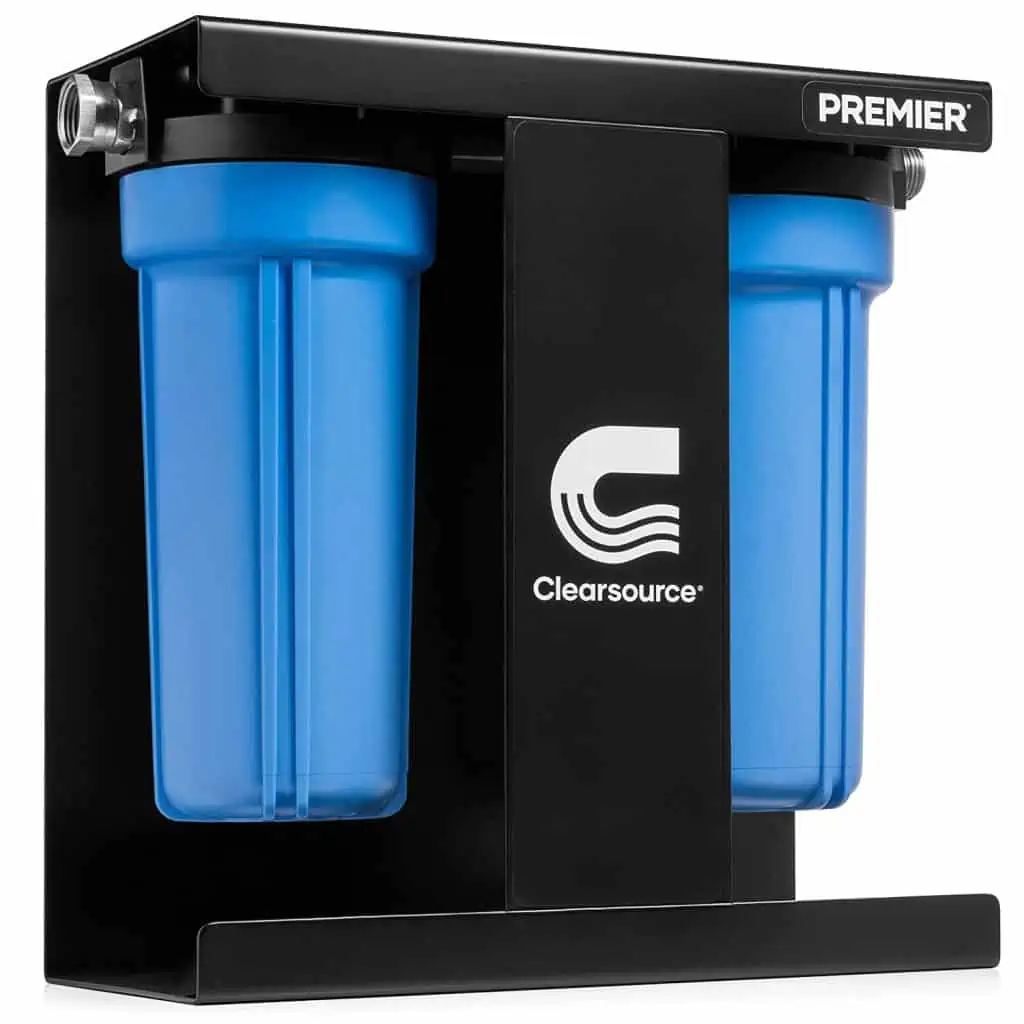
The Clearsource Premium RV Water Filter System is one of the toughest RV water filters we came across throughout our study.
This filter is permanently placed under your RV and is made of sturdy materials to endure for many years.
This filter is far less prone to rust over time than other filters since it contains stainless steel fittings and a powder-coated chassis.
In order to increase its total water flow, it also has bigger canisters.
Before needing to be refilled, these canisters are designed to filter up to 2,000 gallons of water.
Actually, there are two filtering stages in this system.
Your water first travels through a 2.5″ x 10″ 5-micron filter.
This gets rid of bigger sediments.
After that, it goes through a second, 2.5″ x 10″ 0.5-micron filter.
A carbon block made of coconut shell serves as the second stage’s filter, removing impurities such chlorine, cysts, giardia, volatile organic compounds, and others.
This also significantly enhances the flavor and aroma of your water.
The Clearsource Filter System also performs well in terms of preserving the water flow rate via your system.
Once the complete system is permanently fixed in your rig, it is certified to offer a flow rate of up to 6.5 gallons per minute.
The canister filters are simple to detach and replace.
Items We Enjoy
- Powder-Coated Chassis: Increases the corrosion resistance of this filter.
- Stainless Steel Fittings: These are more robust than conventional fittings and are less prone to leak over time.
- Multi-Stage Filtration: The first stage includes a 5-micron filter, while the second stage has a 0.5-micron filter.
- Flow Rate: This filter has a maximum rated flow rate of 6.5 GPM.
Things That We Dislike
- Price: This filter has one of the most expensive price tags of any filter on our list due to the superior materials utilized in its construction.
- Installation: This system has to be set up permanently, which will take a bit more time and effort in the beginning.
#5. Best Under-Sink Filter: Waterdrop TSU 0.01μm Under Sink RV Water Filter
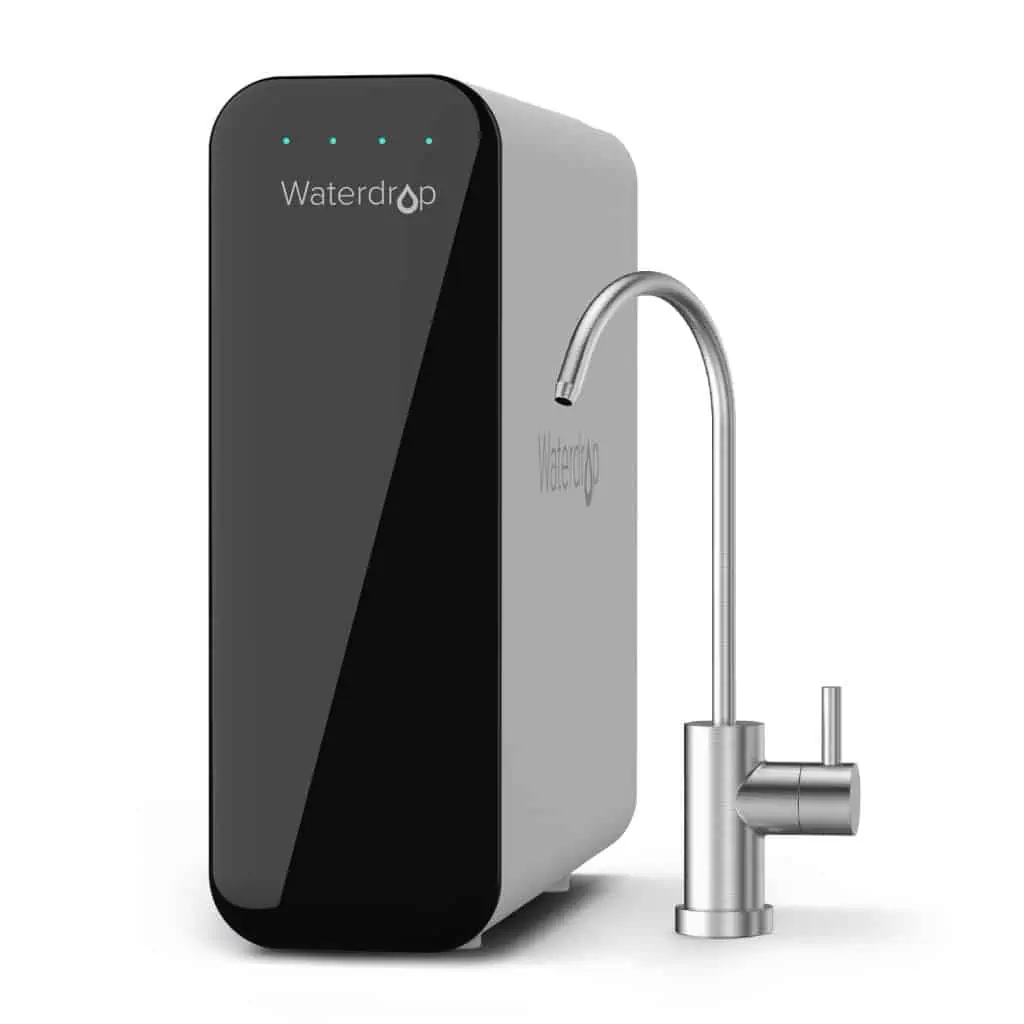
The Waterdrop TSU 0.01-Micron Filter System is a wonderful option if you simply need a water filter that you can put under one or two sinks within your RV.
It has one of the best filter components of any model on our list and is rated to last up to two years.
Before your water exits the faucet, the 0.01-micron filter element removes 99.99 percent of all sediments, bacteria, protozoa, and other pollutants.
After being mounted under your sink, the filter element may be removed and changed without having to move the whole device.
The Waterdrop also has smart technology that shows the functioning mode and water quality.
This enables you to keep a closer eye on the effectiveness of this filter system and when a filter change is necessary.
Additionally, it might provide you with some information into the water quality at various campsites you visit when traveling by RV.
Additionally, the filter unit is simple to install thanks to the built-in waterway.
This filtration system may be installed without interrupting your current water supply, and once it is, the incorporated canal aids in preventing leaks.
Items We Enjoy
- Simple Filter Replacement: You may simply change the filter element without having to remove the complete device.
- Lifetime: This filter has a two-year maximum shelf life.
- Intelligent Technology: Notifies you before a filter change is required.
- Integrated Waterway: Facilitates installation and eliminates leaks.
Things That We Dislike
- Price: For a filter that doesn’t filter ALL of the water entering your RV, this one is a tad expensive.
- Installation: Because this filter is designed to be installed beneath the sink, it won’t shield your RV’s water lines from the accumulation of silt or possibly dangerous substances.
#6. Best Activated Carbon Filter: Culligan RV-800 RV Water Filter with Hose
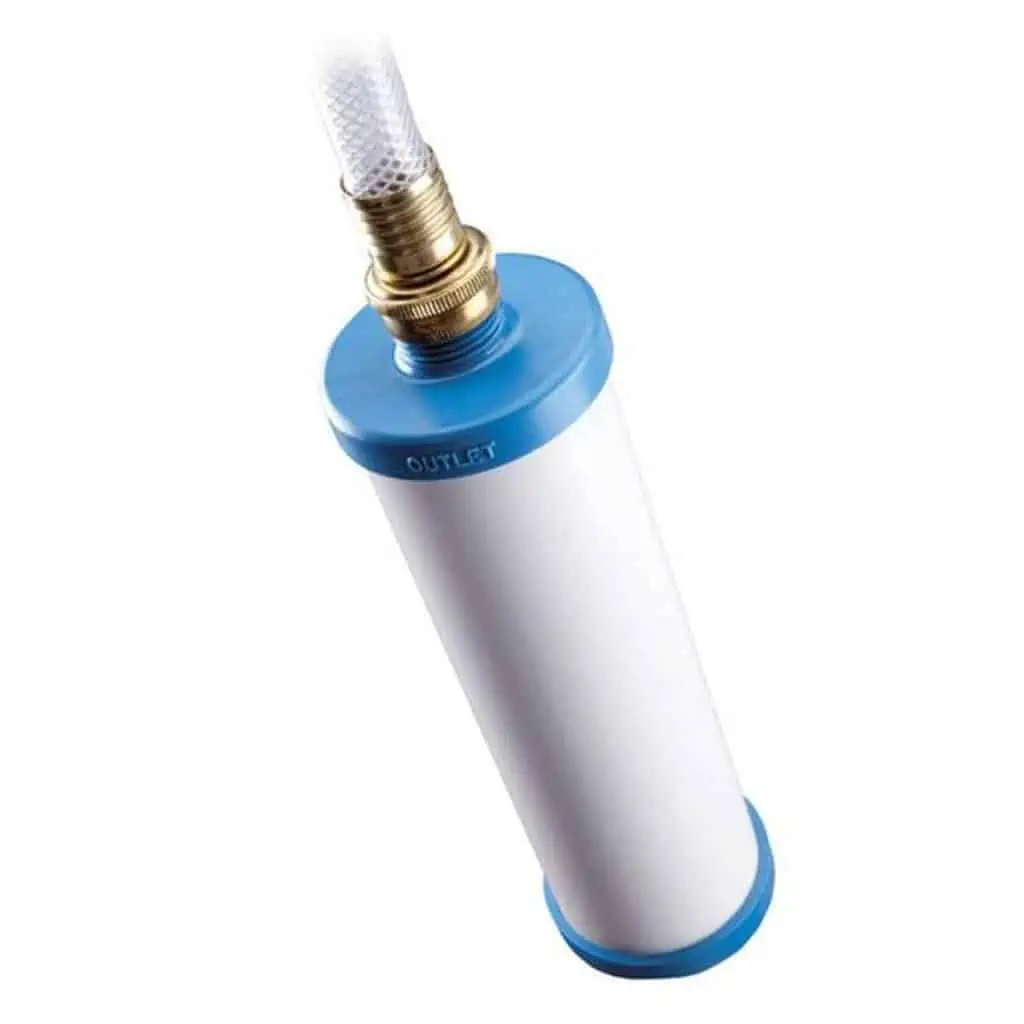
The Culligan RV-800 is another excellent inline water filter if you’re set on the advantages of an activated carbon filter.
It can remove bigger sediments and significantly enhance the flavor and odor of the water entering your RV.
With a 2,000 gallon filter life and the ability to connect to a regular garden hose attachment, it is simple to install.
The frequency of usage and the caliber—or lack thereof—of the water you want it to filter will determine its precise lifetime, it should be mentioned.
The device also has a bacteriostatic filter medium that aims to prevent bacterial growth in addition to an activated carbon filter.
By doing this, you can maintain the purity of your water and maximize the efficiency of the carbon filter element.
A flexible connection line is also included with the Culligan filter to alleviate pressure on the normal fittings.
One of the most typical places where leaks with these filters happen is at the fittings.
Thus, an essential component of any inline filter’s long-term performance is a hose protection.
Items We Enjoy
- Simple to Use: Before connecting to any water source, you just screw it into your regular garden hose.
- Excellent Capacity: This filter has a capacity of 2,000 gallons.
- Bacteriostatic Filter Media: Limits the development of microorganisms within the filter.
- Hose Protector: Aids in preventing leaks at the hose fittings.
Things That We Dislike
- Temperature Range: This filter may not be the greatest choice for very hot or cold conditions since its operating range is between 40 and 100 degrees Fahrenheit.
- Flow Rate: This filter only has a flow rate of 1 GPM at 60 PSI.
#7. Best Three-Canister: Frizzlife Under Sink with Brushed Nickel Faucet SP99
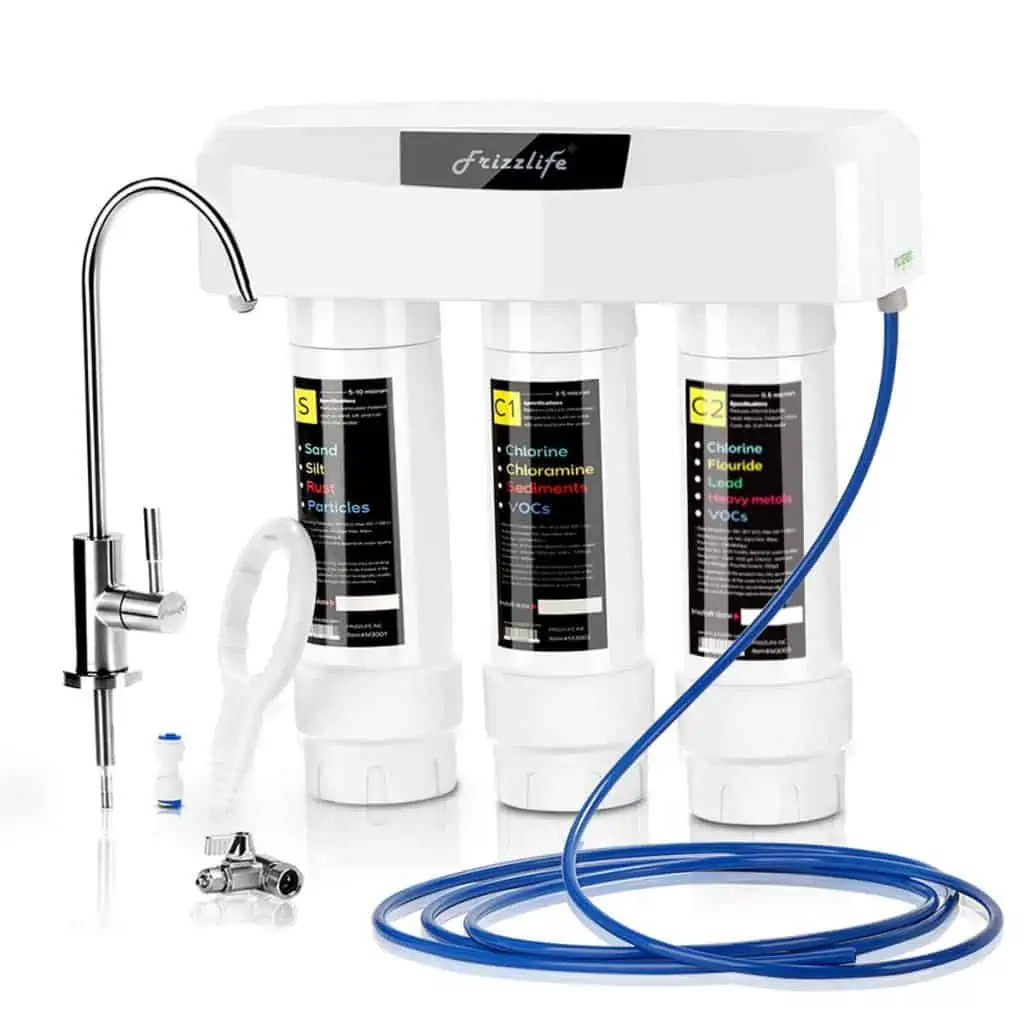
You can think about the advantages of a three-canister water filter if you often visit places where you are aware that the water is contaminated.
And the Frizzlife Under Sink Water Filter System is one of the few products available today that performs better.
This filter won’t take up extra counter space or refrigerator space in your RV since it is designed to be fitted beneath the kitchen or bathroom sink.
Additionally, you won’t have to constantly install and remove it from your RV’s exterior drinking water line while setting up in a different RV park or campsite.
It will thus take a little longer to install initially, but it will continue to operate for you as long as you change the internal filters on a regular basis.
You may save up to 70% over traditional water filters by building this filtration system with replaceable filter cartridges over time since you’ll just need to replace the cartridges rather than the full filtration system.
This filtering system includes a brushed nickel faucet in case you also want to replace the faucet in your RV’s kitchen or bathroom sink.
This enables you to improve the cosmetic finish of your RV’s interior decor while ensuring that you always drink clean, safe drinking water.
Three stages of filtering are used by the Frizzlife filter.
Sediments, rust, dirt, sand, and other big particles are removed in the first step using a five to ten micron filter.
Chlorine, chloramine, smaller particles, and other disagreeable tastes and smells are eliminated in the second stage using a three to five micron carbon block filter.
To eliminate extra chlorine, fluoride, cysts, heavy metals, organic compounds, and cloudiness from your water, the third stage uses a 0.5 millimeter carbon block filter.
Items We Enjoy
- Flow Rate: This filter can provide a flow rate of up to 1.4 gallons per minute when operating at maximum capacity.
- Under-Sink Installation: Keeps the filter out of the way and minimizes the need for continuous setup and maintenance.
- Included Faucet: For a more comprehensive water system improvement, this filter includes a brushed nickel faucet of its own.
- Three-Stage Filtration: Your drinking water is filtered via three stages that eliminate over 99.99 percent of all dangerous impurities.
Things That We Dislike
- Price: This filter costs more than the majority of single-stage or two-stage filters available since it has a three-stage filtering technology.
#8. Best RV Reverse Osmosis: Waterdrop G2 RO Tankless Osmosis Water Filter
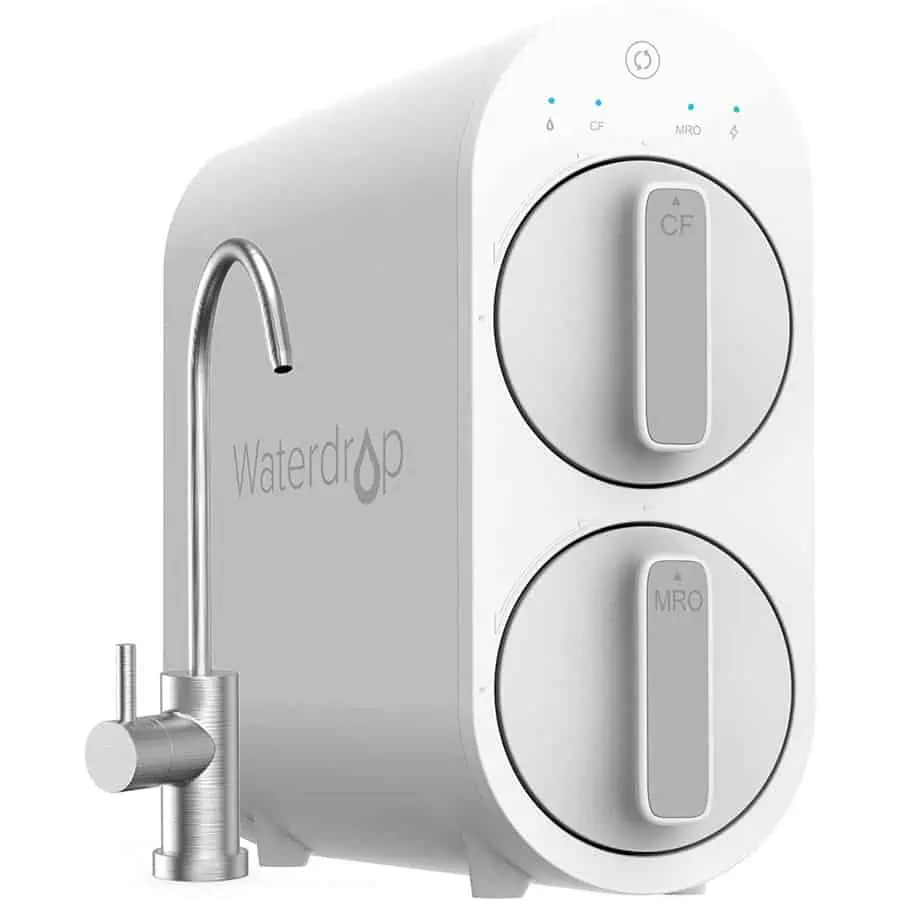
Reverse osmosis, sometimes known as “RO,” is a filtering technique that is highly efficient for long-term usage without requiring regular filter replacement.
So be sure to check out the Waterdrop G2 RO Water Filtration System if you’re looking for a RO water filter.
This filter has a flow rate of 0.28 gallons per minute and a tankless design, which both saves you space and contributes to the filter’s high flow rate.
Additionally, it makes use of composite filters, which have a long shelf life and should generally be changed every six months or so.
Since this filtration system is intended for family RVing with greater levels of water consumption, that filter replacement rate holds true even at high usage rates.
An activated carbon block and a polypropylene (PP) membrane are included in the filter’s construction.
Sediments, rust, excessive chlorine, fluoride, and a total of more than 1,000 pollutants are all successfully removed by the membrane and carbon block filter.
This contains substances that shouldn’t be in your water, such as heavy metals, colloids, big particles, and other organic components.
The tankless design of this filtration system makes it about 70% smaller than most conventional under-the-sink water filters, even though it is intended to be fitted under the sink in your RV.
Waterdrop created this filtering system with integrated electrical and water circuits since it is intended to tuck away behind your sink.
Due to this design, the likelihood of electrical blackouts caused by water leaks from other parts of your RV are also reduced.
By following the comprehensive installation instructions that are included with the filtration system, the Waterdrop G2 may be installed in approximately 30 minutes.
When it’s time to change the filters, all you have to do is twist and take them out of the main body of the filtration system.
As a result, you may finish in under three seconds and resume filtering delicious, pure water.
Items We Enjoy
- Lifespan of Filters: This system’s filters are intended to endure at least six months even under heavy use.
- Tankless Design: This conserves space beneath your sink and increases the flow rate of this system.
- Integrated Circuitry: By lowering the likelihood of electrical shortages, it reduces leaks and encourages safer usage.
- Filter Replacement: Once the first installation is finished, replacing filters only takes around three seconds.
Things That We Dislike
- Price: This isn’t the cheapest RV water filter on the market because of its advanced reverse osmosis technology and space-saving design.
RV Water Filtration System Types
There are four main categories in which most RV water filters may be found.
Therefore, it makes sense to begin by outlining each kind and discussing some of its benefits and drawbacks.
#1. Deposition Filters
Similar to a regular pasta strainer, sediment filters function by allowing water to flow through considerably tiny pores.
These filters are excellent at eliminating substantial particles from your water as it moves through the strainer, living up to their name.
The sediments often end up remaining in your filter and building up over time due to the way they are made.
As a result, you could find that your water’s flow rate slows down over time.
Therefore, it is necessary to clean and flush sediment filters more regularly if you want to maintain their effectiveness and extend their lives.
The finest RV filters often use various filtering techniques.
However, putting a sediment filter in your RV is often the very minimum level of security you should think about doing to ensure cleaner drinking water.
#2. CO2 Filters
The best option for enhancing the flavor and odor of the water in your RV is generally thought to be an activated carbon filter.
These versions also lessen the unpleasant chlorine taste that some water has, which is not something you can anticipate from a sediment filter.
Granulated activated carbon, a solid block of carbon, or a modified carbon block are the common materials for the filter component.
Although they aren’t nearly as efficient as the other forms, granulated activated carbon filters are the most often used and least expensive.
Small grains of activated carbon, which are quite similar to the charcoal some people use for campfire cooking, are passed through your water to make them operate.
Since water is less likely to create channels within the filter, filters that employ solid blocks of carbon are more efficient.
By doing this, you can be sure that the carbon filter truly contacts all of your water.
These elements are created by crushing activated carbon, which is subsequently solidified under high pressure.
These filters are more costly than certain other kinds of filters in part because to the additional manufacturing procedure.
A modified carbon block that performs similarly to a solid carbon block filter is used in the third kind of carbon filter.
However, improvements made to these filters allow for a higher flow rate and longer lifespan.
As you may anticipate, this might also cost more money.
Many of these filters are efficient in removing impurities, including harmful heavy metals like mercury, asbestos, lead, and other volatile organic compounds, in addition to enhancing the taste and flavor of your water.
#3. Pottery Filters
Ceramic elements with tiny pores are used in ceramic filters.
For your RV’s clean drinking water supply, these filters filter away sediments, giardia cysts, bacteria, and protozoa.
These kinds of compounds are successfully removed, however they are less successful in removing chemical contaminants.
Some ceramic filters do, however, include a carbon element that enhances their capacity to filter pollutants and, as a result, enhances the flavor and odor of your drinking water.
As a result, be sure to ensure that the ceramic filter you’re interested in contains a carbon filter element of some kind.
#4. Filters for Reverse Osmosis
The most cutting-edge sort of filter is a reverse osmosis unit, which can create water that is almost completely clean.
They depend on a membrane that is semi-permeable and can prevent any particles bigger than a single water molecule.
As a result, they are also particularly good at purifying your water of nitrates, arsenic, fluoride, perchlorate, and hexavalent chromium.
Chlorine is the one substance they cannot get rid of.
So, if you choose a reverse osmosis filter, make sure it also has a carbon element of some kind to get rid of chlorine.
The Right RV Water Filter Depends On You.
You may ask what kind of filter would best meet your demands when it comes to a water filtration system.
The best filter for your RV will primarily rely on your demands for water filtration and how you RV.
Here are some considerations to ponder when selecting a water filter for your RV.
#1. What Should You Filter?
You may choose the best kind of filter by being aware of the most typical forms of pollutants that need to be filtered.
You may always do a water test to determine precisely what is in your water if you only park your RV in one or two spots on a regular basis.
You’ll be able to pick the suitable filter type when you have a clearer understanding of what you’ll need to filter.
It’s not practical to do a water test every time you enter a new park if you’re an RVer who travels often.
The majority of RV parks have access to municipal water, which usually contains chlorine.
Having said that, you can typically rely on municipal water to be treated to eliminate germs that might cause waterborne diseases, thus a carbon filter will typically be sufficient to enhance the flavor and odor of city water.
However, some parks could provide their own water via a well on the grounds.
High concentrations of sediments, heavy metals, and potentially dangerous bacteria and germs are often found in well water.
This will call for a filter that can get rid of these kinds of impurities.
Furthermore, regardless of the source of the water, certain locations have “harder” water than others.
‘Hard’ water often has high concentrations of calcium and magnesium, which may sometimes accumulate in your RV’s water pipes and eventually lead to damage.
The final fact is that RVers are better served by a more thorough filter.
RVers who want to travel often need a filter that can get rid of sediments, chlorine, bacteria, and a wide range of chemical and metal pollutants.
This will offer you the assurance that your filter will work hard to protect you regardless of the water quality wherever you connect up next.
#2. How Much Filtered Water Is Required?
How much water you want to filter will be your next choice.
You can get away with an under-the-sink model if all you want to do is filter the water that comes out of your kitchen sink for drinking and cooking.
However, you’ll need either an inline filter or a canister-style system if you want to filter all of the water entering your RV.
Remember that installing a whole-RV filtration system can also safeguard your pipes against the accumulation of calcium, magnesium, and particles that may cause plumbing problems, even if you may not feel like you need filtered water for your shower or toilet flushing.
#3. When Will You Use the Filter?
You should also think about how often you intend to use your RV water filter.
RVers who live in their vehicles full-time will need a filter that will last longer and be more robust than those who just use them sometimes during the summer.
Additionally, filtering from a wider range of surfaces will need a bigger investment in a filter with more features.
You may probably get away with a simpler water filtration arrangement if you virtually always hook up to city water when traveling in your RV.
However, you’ll need a filter that can get rid of the kinds of germs and microbes that are typical of rural water sources if you plan to keep your RV off the grid for weeks or months at a time.
Additionally, consider how long a particular filter will last before needing to be replaced.
You will always need to arrange your RV trips around the possibility that you may need to change a filter, particularly if you’re living remotely, if you’re not always in a location where you can quickly dash to the next Wal-Mart to acquire a new filter.
#4. Size in Microns
The micron rating of a filter provides extra information about the size of the particles that it will let to pass through.
Consequently, a filter rated at 0.1 microns will filter more particles than a filter rated at 2 microns.
A sign like this “m” may also appear in front of a filter’s micron rating.
This is short for submicron and is exclusively used by filters that remove the tiniest particles from drinking water.
#5. Installation and Use are Simple
We strongly advise picking a filter with a simple installation procedure unless you have a lot of expertise with plumbing systems.
You run the danger of jeopardizing the system’s watertight integrity if you have to make modifications to your RV’s current water system in order to install your new filter.
After you install your new water filter, the long-term repercussions might be disastrous if you don’t realize that your RV’s water system has a little leak.
If left unattended, even the slightest leaks may result in dry rot, mold, and/or mildew.
For this reason, if you’re uncomfortable with the installation procedure that goes along with canister-style systems, we advise using an inline water filter.
These filters don’t need any tampering with the pipes in your RV’s water system, but you will need to screw them into place each time you connect to a new water source.
However, these filters are the simplest to utilize over time provided you are confident in your ability to install a canister-style system and are at ease with plumbing.
Your procedure for connecting to a new water source will basically be the same as it was before installing a new RV water filter once you go through the more difficult installation process.
#6. Price (And Cost Over Time)
It’s critical to look beyond the initial expense of a new water filter while considering your bottom line.
You should also take into account the expense of maintenance as well as a complete filtration system replacement.
Furthermore, filters with more difficult installations often have higher lifetime maintenance costs.
Therefore, be sure to take this into account while evaluating water filters to determine which one will provide you the most value.
Which Is Best For You, Then?
The Camco 40043 TastePure is our pick for the finest all-around RV water filter because it’s simple to install, very flexible, and incredibly economical.
The regular garden hose you use to connect your RV to city water easily screws into the inline filter.
Additionally, it enhances the flavor and odor of your water while removing a broad range of pollutants and heavy metals.
However, if money is limited and you’re searching for a filter that’s inexpensive but still delivers good results, we suggest the Hydro Life 52700 Inline Water Filter.
This filter can last up to 8,000 gallons and can remove sediments, bacteria, and chemical impurities for your water despite its very affordable price.
Along with being very simple to install, it has uses other than just RV water filtering, such as urban farming, hydroponic gardens, and more.
#1. How Does A Water Filter For An RV Operate?
The present water system in your RV may be upgraded with an RV water filter.
The water that is flowing from your municipal water connection or aboard water tank flows through the filter in the finest designs before it travels through your water pipes and exits the faucet that you just opened.
These filters remove bigger particles from your water, but the better ones also get rid of germs and protozoa that are minuscule and may make you sick.
These filters purify your water using one of two fundamental filtering techniques.
Some people filter things physically, while others filter things chemically.
The most effective models actually combine these two filtering techniques.
The best method for eliminating big particles from your water is physical filtration.
This kind of filtration uses a device that resembles a sieve to trap dirt and other impurities as your water runs through it.
While some filters utilize a material resembling thin gauze to filter big particles, others use a kind of tiny textile membrane.
Chemical filtration purifies your water by using a specific chemical that is known to eradicate bacteria, protozoa, and other pathogens.
Just three of the numerous typical chemicals used in water filtration are iodine, chlorine, and algicide.
It is well known that this sort of filtration works better when it comes to clearing your water of possibly harmful microscopic organisms.
The ideal RV water filter will combine these two filtering techniques, as we briefly discussed above, to remove big sediments as well as neutralize tiny bacteria and protozoa.
#2. What’s The Lifespan Of An RV Water Filter?
Your choice of filter and how you apply it will determine the precise response to this inquiry.
The good news is that most filter makers openly promote how long their products will last when used often.
If you don’t use your filter every day, you may be able to increase its lifetime in specific circumstances.
While some filters only last three months, others might endure for up to a year.
It’s normally advised to change your filter every three to six months when using it often, even if you pick one with a lengthy lifetime.
In addition, your water filter may sometimes suffer from extended periods of inactivity.
If they aren’t used often, filters with a ceramic or charcoal element within, for instance, may dry up and break.
And you should never rely on a filter with a damaged element to perform the function for which you purchased it.
#3. How Do I Put In (Or Replace) A Water Filter For An RV?
Again, the precise procedure for installing or replacing an RV water filter may vary depending on the type you’ve chosen.
The easiest solution to this problem is to carefully read your user’s handbook and strictly adhere to the installation instructions when setting up or replacing an RV water filter.
Inline water filters have the easiest installation, so to speak.
These filters need only be fitted into the water hose that runs from your RV’s water input to the city water output.
However, you’ll need to install a canister-style water filter beneath your RV permanently if you buy one.
This kind of filter requires initial meticulous plumbing work since it also has to be linked to your RV’s water lines.
The first crucial step is to make sure the water is shut off to your rig and you take a little time to empty the pipes, regardless of whether you need to install or replace an inline or canister filter.
As soon as you start removing any hose fittings, this will assist you from getting any water in the compartments below your RV.
Next, check that your filters are correctly positioned so that water is flowing through them in the right direction.
The majority of filters will have obvious labels that help you distinguish between “input” and “output,” but if you’re still unsure, you should always refer to your user manual.
Connect all of the hoses and pipe fittings and tighten them after you’re certain that everything is correctly aligned.
But to ensure a watertight seal, be sure to wrap all fittings with plumber’s tape.
The filter may be mounted using the supplied hardware once everything has been connected and checked to ensure there are no leaks.
In order to guarantee that everything remains leak-free during the course of your filter, this helps to remove any weight from the filter and its connections.
#4. Is Hot Water Compatible With A Water Filter?
No, in a nutshell, is the response.
Using hot water with most of these filters may actually reverse the filtering process and cause pollutants to be discharged back into the water since they were not designed to handle hot water.
The best course of action is to contact the manufacturer first if you are unsure whether or not you can run hot water through a particular kind of water filter.
However, you can always correct it if you mistakenly put hot water through your filter by immediately running cold water through it for at least two minutes.
#5. How Is An RV Water Filter Cleaned?
The easiest method to extend the life of an RV water filter is to keep it clean.
In other words, cleaning your water filter more often will cut down on the need for filter replacement totally.
Backflushing an RV water filter is the first step in cleaning it.
In order to do this, pure water must be forced through the filter against its natural flow.
To backflush the filter and remove any material that has built within, you may need to manually reverse the filter’s flow or attach an external hose, depending on the kind of filter.
The easiest technique to create enough water pressure to effectively remove bigger bits of debris that may be caked within the filter while backflushing smaller filters is to use a syringe.
However, a typical garden hose should work for bigger filters.
If your filter has been dry for a while, you should wait a few minutes before backflushing it with water flowing in the typical direction.
This will moisten the parts and aid to start releasing any debris’ or bacteria’s grip on them.
You may also need to disassemble a ceramic filter in order to physically clean the filter.
Always use a brush with very gentle bristles to prevent scratching the ceramic filter while doing this.
Consulting your owner’s handbook is the best approach to be sure you’re using the appropriate kind of brush.
Some filter owners also like to clean their filters with chlorinated tap water.
When you flush the filter at the same time as doing this, it performs a better job of neutralizing any minute bacteria or protozoa that have gathered within the filter.
Use at least one gallon of chlorinated tap water to flush the filter if you use this approach.
before using it for drinking or washing dishes, pour another gallon of pure, clean water through the filter.
By doing this, you can make sure that your filter is no longer filled to the brim with chlorinated water.
You may also use a solution of tap water and bleach if, for whatever reason, you are unable to get chlorinated tap water.
If you want to use this method, be careful to use no more than eight drops of clear, unscented liquid bleach per gallon of fresh tap water.
After giving the mixture a good stir, let it rest for at least 30 minutes.
Then, using this bleach water solution, backflush your filter.
Before reconnecting the filter and running your drinking water through it once again, make sure you pour at least one more gallon of clean tap water (without bleach) through it.
Conclusion
I can speak from personal experience when I say that drinking water with a bad taste may be difficult.
This is particularly true if you live somewhere where the tap water is naturally delicious and very clean.
The good news is that if you live or travel in an RV, you don’t have to accept crappy water.
With the aid of the finest RV water filter, you’ll be able to more easily appreciate the flavor of whichever city water connection you choose to connect to.
But more significantly, it will protect you from any sicknesses or germs that could be in your water if it hasn’t been thoroughly filtered before it gets to your rig.
Investing in an RV water filter makes perfect sense if you just want to be safe and ensure that you always have access to clean water wherever you go.
Additionally, it’s a financial investment in both your own health and the health of everyone else who rides in your RV with you.

